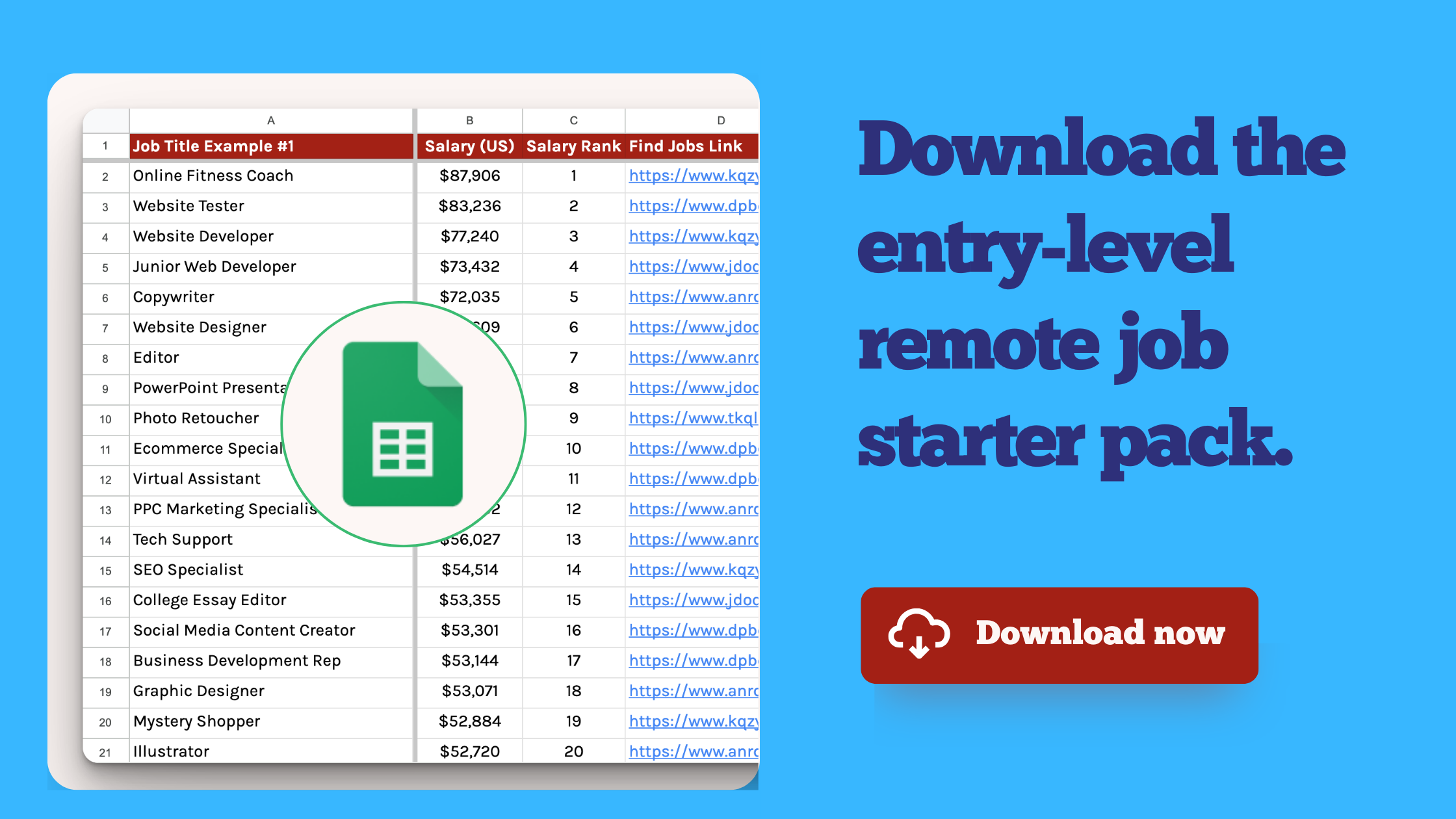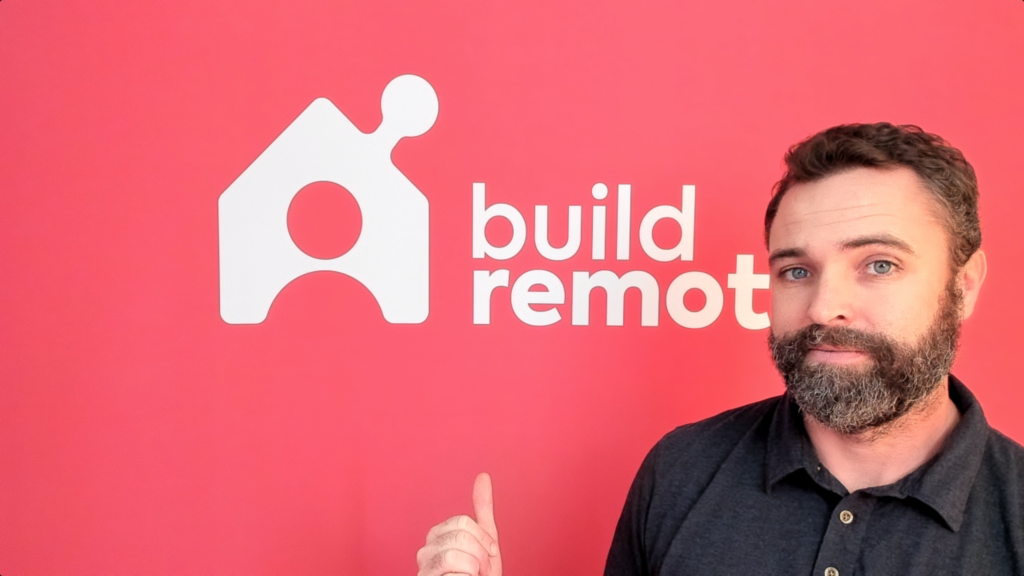27 Best Remote Side Hustles

There are two good ways to start a search for remote side hustles: 1) look for skills and careers that are conducive to online, remote side hustles, or 2) find a marketplace with online projects and jobs.
In this article, we’ve covered both options in depth. Click a link below to start your remote side hustle search in whichever way works best for you:
- 27 best side hustle, remote jobs (plus hourly earning potential for each)
- 20 online marketplaces to find remote side hustles
- The story behind my remote side hustle
👉 Remote Side Hustles 👈
To analyze your potential to earn in a remote side job, start with what you’re good at. Below, you’ll find 27 skills that are frequently hired for as remote, work-from-anywhere freelancers (or, side hustles). Take a look at the list to find a few of the skills you might possess.
Then, take a look at the average earning potential per hour. The average hourly rate you’ll see below is taken the average salary listed on Payscale.com, then translated into an hourly rate (salary/52 weeks/40 hours per week).
Finally, you’ll see a recommendation for the best marketplace or platform to find these type of remote side gigs.
Website Tester
Description: Evaluates websites to ensure they are intuitive, easy to navigate, and free from bugs.
- Average Hourly Rate: $40
- Earnings Potential Rank: #1
Search for remote jobs on Flexjobs. | Search for remote side gigs on Upwork.
Technical Writer
Description: Creates clear and concise guides and documentation to help users understand complex technical products.
- Average Hourly Rate: $33
- Earnings Potential Rank: #2
Search for remote jobs on Flexjobs. | Search for remote side gigs on Hubstaff.
Junior Researcher
Description: Assists in conducting detailed investigations and analysis in a particular field or subject.
- Average Hourly Rate: $31
- Earnings Potential Rank: #3
Search for remote jobs on Flexjobs. | Search for remote side gigs on Upwork.
Junior Motion Graphic Artist
Description: Supports the creation of animated and motion graphics under the guidance of a senior artist.
- Average Hourly Rate: $29
- Earnings Potential Rank: #4
Search for remote jobs on Flexjobs. | Search for remote side gigs on Upwork.
Creative Graphic Designer
Description: Designs visually appealing graphics and layouts for various media and marketing materials.
- Average Hourly Rate: $26
- Earnings Potential Rank: #5
Search for remote jobs on Flexjobs. | Search for remote side gigs on Upwork.
Social Media Content Creator
Description: Develops and publishes engaging content for various social media platforms.
- Average Hourly Rate: $26
- Earnings Potential Rank: #6
Search for remote jobs on HireBasis. | Search for remote side gigs on PeoplePerHour.
Legal Transcriptionist
Description: Transcribes legal documents and proceedings with a high level of accuracy and confidentiality.
- Average Hourly Rate: $25
- Earnings Potential Rank: #7
Search for remote jobs on Flexjobs. | Search for remote side gigs on Fiverr.
Documentation Specialist
Description: Manages and organizes important documents, ensuring accuracy, accessibility, and compliance.
- Average Hourly Rate: $24
- Earnings Potential Rank: #8
Search for remote jobs on Flexjobs. | Search for remote side gigs on Fiverr.
Blog Writer
Description: Produces informative and engaging content for blogs across various niches.
- Average Hourly Rate: $24
- Earnings Potential Rank: #9
Search for remote jobs on Flexjobs. | Search for remote side gigs on Hubstaff.
Copy Editor
Description: Reviews and revises content for clarity, grammar, and accuracy before publication.
- Average Hourly Rate: $23
- Earnings Potential Rank: #10
Search for remote jobs on Flexjobs. | Search for remote side gigs on Upwork.
Social Media Specialists
Description: Manages and grows an organization’s presence across social media channels.
- Average Hourly Rate: $23
- Earnings Potential Rank: #11
Search for remote jobs on Flexjobs. | Search for remote side gigs on PeoplePerHour.
Translator
Description: Converts written material from one or more ‘source languages’ into the ‘target language’, ensuring the meaning is kept.
- Average Hourly Rate: $22
- Earnings Potential Rank: #12
Search for remote jobs on Flexjobs. | Search for remote side gigs on Fiverr.
Graphic Artist
Description: Creates visual concepts by hand or using computer software to communicate ideas that inspire, inform, or captivate.
- Average Hourly Rate: $22
- Earnings Potential Rank: #13
Search for remote jobs on Flexjobs. | Search for remote side gigs on Upwork.
Copywriter
Description: Writes persuasive marketing and promotional materials to drive customer interest and action.
- Average Hourly Rate: $22
- Earnings Potential Rank: #14
Search for remote jobs on Flexjobs. | Search for remote side gigs on Hubstaff.
Game Tester
Description: Plays games in development to find and report bugs and glitches to the development team.
- Average Hourly Rate: $22
- Earnings Potential Rank: #15
Search for remote jobs on Flexjobs. | Search for remote side gigs on Upwork.
Online English Teacher
Description: Teaches English to students of varying ages and levels over the internet.
- Average Hourly Rate: $22
- Earnings Potential Rank: #16
Search for remote jobs on Flexjobs. | Search for remote side gigs on Tutor.com.
Online Tutor
Description: Provides instructional support and guidance to students in various subjects via the internet.
- Average Hourly Rate: $22
- Earnings Potential Rank: #17
Search for remote jobs on Flexjobs. | Search for remote side gigs on Tutor.com.
Research Analyst
Description: Gathers, interprets, and uses complex data to develop actionable steps that will improve processes or products.
- Average Hourly Rate: $21
- Earnings Potential Rank: #18
Search for remote jobs on Flexjobs. | Search for remote side gigs on Upwork.
Remote Virtual Assistant
Description: Provides administrative support to businesses or entrepreneurs from a remote location.
- Average Hourly Rate: $21
- Earnings Potential Rank: #19
Search for remote jobs on Flexjobs. | Search for remote side gigs on Upwork.
Virtual Administrative Assistant
Description: Handles administrative tasks like email correspondence, scheduling, and bookkeeping remotely.
- Average Hourly Rate: $21
- Earnings Potential Rank: #20
Search for remote jobs on Flexjobs. | Search for remote side gigs on Upwork.
Junior Copy Editor
Description: Assists in refining written materials to enhance clarity and consistency under the supervision of a senior editor.
- Average Hourly Rate: $20
- Earnings Potential Rank: #21
Search for remote jobs on Flexjobs. | Search for remote side gigs on Upwork.
Social Media Assistant
Description: Supports social media strategies, content creation, and community management under supervision.
- Average Hourly Rate: $20
- Earnings Potential Rank: #22
Search for remote jobs on Flexjobs. | Search for remote side gigs on PeoplePerHour.
Content Moderator
Description: Monitors user-generated content on websites or social media platforms to ensure community guidelines are adhered to.
- Average Hourly Rate: $19
- Earnings Potential Rank: #23
Search for remote jobs on Flexjobs. | Search for remote side gigs on Upwork.
Data Entry Technician
Description: Inputs, updates, and maintains information in computer systems or databases.
- Average Hourly Rate: $18
- Earnings Potential Rank: #24
Search for remote jobs on Flexjobs. | Search for remote side gigs on Fiverr.
Data Entry Specialist
Description: Specializes in quickly and accurately entering data into various computer systems.
- Average Hourly Rate: $18
- Earnings Potential Rank: #25
Search for remote jobs on Flexjobs. | Search for remote side gigs on Fiverr.
Virtual Receptionist
Description: Manages a company’s incoming calls, messages, and appointments remotely.
- Average Hourly Rate: $17
- Earnings Potential Rank: #26
Search for remote jobs on Flexjobs. | Search for remote side gigs on Upwork.
Data Entry Clerk
Description: Enters and updates information in a database or computer system, ensuring accuracy and speed.
- Average Hourly Rate: $17
- Earnings Potential Rank: #27
Search for remote jobs on Flexjobs. | Search for remote side gigs on Fiverr.
See Also: 36 Easy Remote Jobs (Filter By ‘Type Of Easy’) | Remote Jobs For College Students | 24 Best Remote Jobs For Teachers In Summer | 20 Best Overnight Remote Jobs Ranked By Income
Best Marketplaces For Side Hustles From Home
The other way to find a side-hustle, remote job that is a good fit is to find the right platform where freelance jobs are posted. We talked about these platforms in our post about work-from-home, make-your-own-schedule jobs.
In the table, you’ll see the name of the marketplace, a link to sign up to find jobs, the main job types on the platform, and the estimated monthly visitors to the website according to a tool named Semrush. I included this column to give an idea of the size of the platform (how many people use it in some way each month).
| Marketplace | Find Side Hustles | Types Of Jobs | *Monthly Visitors |
|---|---|---|---|
| Fiverr | Click here | Design, Marketing, Writing, Video, Animation, Audio, Programming, and more… | 93,600,000 |
| Upwork | Click here | Virtual Assistance, Accounting, Support, Sales Marketing, Design, Development, Writing, and more… | 56,800,000 |
| Dribbble | Click here | Graphic Design | 23,180,000 |
| Freelancer.com | Click here | “Design, PR, Translation, Research, Development, Marketing, Writing, and more… | 8,490,000 |
| Toptal | Click here | Development, Design, Finance, Product Management, Project Management | 5,190,000 |
| 99Designs | Click here | Graphic Design | 5,120,000 |
| PeoplePerHour | Click here | Design, Writing, Translation, Design, Support, Marketing, Programming, and more… | 3,500,000 |
| Hubstaff Talent | Click here | Development, Marketing, Design, Writing, IT, and more… | 3,140,000 |
| Guru | Click here | Development, Writing, Translation, Art, Administrative, Legal, and more… | 1,280,000 |
| DesignCrowd | Click here | Design | 800,000 |
| Tutor.com | Click here | Tutoring | 630,000 |
| Truelancer | Click here | Programming, Design, Writing, Data Entry, Customer Support, and more… | 570,000 |
| Contently | Click here | Writing | 430,000 |
| ProBlogger | Click here | Writing | 190,000 |
| NoDesk | Click here | Support, Design, Marketing, Sales, Operations, and more… | 150,000 |
| FreeUp | Click here | Inventory Management, Support, Design, Marketing, Accounting, Finance, and more… | 130,000 |
| Codeable | Click here | WordPress Development | 90,000 |
| Gun.io | Click here | Software Development | 50,000 |
| HireBasis | Click here | Multiple Job Types (All Remote) | 40,000 |
*This is an estimate of the monthly web visitors to the site according to Semrush.
See Also: 42 Entry-Level Remote Jobs | No-Phone, Work-From-Home Jobs | 36 Easy Remote Jobs
Buildremote: My Remote Side HustleWhy did I write this post? You are visiting my first remote side hustle right now! I started Buildremote in 2020 and ran it as a side hustle until the fall of 2022. That’s when it became my full-time business as I left the company I worked at for over eight years. I wanted to compile a helpful report so other people can find a great side hustle from home, as well. If you have any questions about how or why I decided to start Buildremote (and the opportunity to build your own side hustle), reach out here. |
How To Find Flexible, Remote Work
There is one big, trustworthy job board specifically for flexible schedule and remote work jobs. That is Flexjobs. Now, this is not necessarily the right place for remote side hustle jobs. It is more for full-time and part-time work work at remote and flexible companies. But I wanted to mention it as an option.
Find a flexible, remote position now.
What is the best remote side job?
It depends on what you have as a skill. But generically speaking, these are some of the highest-paying (by hour) side hustles you can do from home:
- Testing: Website Tester, Game Tester ($30.80 per hour)
- Writing: Copywriter, Blog Writer, Technical Writer ($24.18 per hour)
- Research: Research Analyst, Junior Researcher ($23.15 per hour)
- Translation: Translator ($22.24 per hour)
See Also: Companies With Unlimited PTO & Remote Work
What is the easiest side hustle online?
This, too, depends on the skills you possess. Writing jobs might be easy to one person while researching may be hard to another. Pick the skill in which you can bring the most value, and that will be the easiest. From our list, these might be some good options:
- Data Entry
- Virtual Assistance
- Social Media Management
- Transcription
- Photo Editing
See Also:
- 27 Best Work-Life Balance Jobs (By Degree)
- 45 Work-From-Home Jobs That Provides Equipment
- Every Remote Job Board That Matters
Explore These Helpful Email Templates for Remote Job Interviews
Navigating the remote job market can be challenging, especially when crafting the perfect email. To assist you, we’ve compiled a list of blog posts offering essential email templates for remote job interviews. Whether you need to write a compelling application, schedule an interview, or follow up afterward, these resources will help you communicate professionally and effectively.
- How To Email A Job Recruiter [TEMPLATE]
- Email Expressing Job Interest [TEMPLATE]
- How To Write An Email Requesting A Job Interview [TEMPLATE]
- Email To Confirm An Interview [TEMPLATE]
- Email To Accept A Job Interview [TEMPLATE]
- Email To Reschedule An Interview [TEMPLATE]
- Email To Decline An Interview [TEMPLATE]
- Email To Cancel An Interview [TEMPLATE]
- Emails Asking For Interview Feedback [TEMPLATE]
- 2 Interview Thank You Email [TEMPLATE]
- Short Thank You Email After Interview [TEMPLATE]
- 1st Follow-Up Email After An Interview [TEMPLATE]
- 2nd Follow-Up Email After Interview [TEMPLATE]
- Interview Follow-Up Email After 2 Weeks [TEMPLATE]
- Follow-Up Email After A Phone Interview [TEMPLATE]
- Refer-A-Friend Email Example [TEMPLATE]
- Email Before Starting A New Job [TEMPLATE]
- 21 Remote Interview Email Templates


